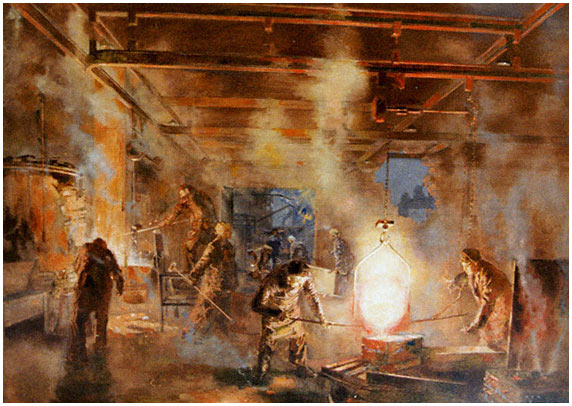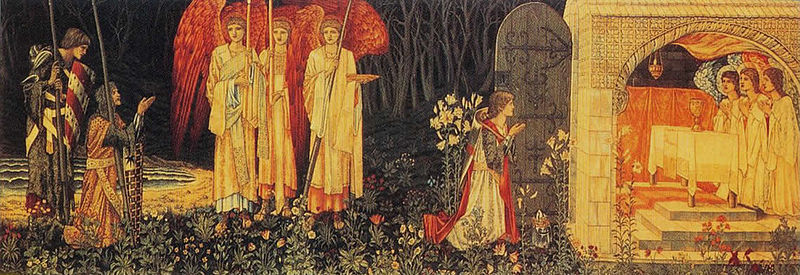Clement Pulaski
Daily Stormer
July 17, 2013
William Morris was a 19th century British artist, writer, and activist. Today he is considered to have been liberal in his political leanings, and he was at one time the leader of the Socialist League. But despite the socialist label, much of what Morris taught and did was completely opposed to the Jewish Marxism that came to define left-wing socialism in the 20th century. In many ways his attitude towards life was organic and folkish. Morris was concerned not only with political organization, but with the need for the man-made environment in which we live to be rooted in tradition. In his view men are not simply autonomous consumers and producers whose environment can be maximized by the latest technology. Thus Morris was alarmed by the emergence of industrially produced furniture, clothing, buildings, etc. These soulless, utilitarian objects were destroying the aesthetic environment and brining about the eradication of British folk art. In an effort to combat this development, Morris became the leading proponent of the Arts and Crafts movement, which attempted to revive traditional styles not only in painting and sculpture, but in the design of everyday objects like wallpaper, tiles and furniture.

Industrial society is evil not only because of wealth inequality and cruel labor conditions, but because it separates man from the beauty of the world. By this measure one can see that Jewish Marxism is just as much of a failure as industrial capitalism. This is made especially clear if we compare side by side the art of Morris and the art of the Soviet Union. Generally speaking, the Soviet Union sanctioned two types of art, avant-garde and socialist realism. Both styles fail to connect us with the heroic past of our folk.

Avant-garde art is the product of rootless, materialistic individuals who cannot think beyond their own solipsistic theories. The development of modern avant-garde art can be seen as a visual representation of the progressive psychosis of modern man. It is not surprising that this sytle was popular both in the capitalist West and the Soviet Union, while it was banned in the Third Reich.

While socialist realism was not as obviously decadent as avant-garde art, it was severely limited in scope. This style was restricted to more or less realistic representations of the working class and communist leaders, the main subjects of Soviet propaganda. In fact the style was completely propagandistic, and was intended to instill in the masses communist values. While socialist realism did not contain the bizarre nightmare figures of the avant-garde, it left out anything romantic, sublime, or transcendent.
If we turn now to the work of Morris, it becomes evident that while he may have born the label “socialist”, his spirit is as far from Jewish Marxism as possible.

This work of art displays heroism, chivalry, reverence for the divine, and a great respect for the character and physical beauty of our race. In this image one can see everything that offends the Jew.
I end this post with an extensive quote from Morris’ book The House of the Wolfings. In promoting his folkish socialism, Morris often made reference to the institutions of medieval England and the ancient Germans. The House of the Wolfings is a tale of ancient Germanic heroism in the face of a Roman invasion. These opening pages of the book describe the idyllic life of the fictional Germanic tribe of the “Wolfings”. The purity of living that these pages communicate should be an inspiration to all white men who wish to revolt against the Jewish New World Order:
The tale tells that in times long past there was a dwelling of men beside a great wood. Before it lay a plain, not very great, but which was, as it were, an isle in the sea of woodland, since even when you stood on the flat ground, you could see trees everywhere in the offing, though as for hills, you could scarce say that there were any; only swellings-up of the earth here and there, like the upheavings of the water that one sees at whiles going on amidst the eddies of a swift but deep stream.
On either side, to right and left the tree-girdle reached out toward the blue distance, thick close and unsundered, save where it and the plain which it begirdled was cleft amidmost by a river about as wide as the Thames at Sheene when the flood-tide is at its highest, but so swift and full of eddies, that it gave token of mountains not so far distant, though they were hidden. On each side moreover of the stream of this river was a wide space of stones, great and little, and in most places above this stony waste were banks of a few feet high, showing where the yearly winter flood was most commonly stayed.
You must know that this great clearing in the woodland was not a matter of haphazard; though the river had driven a road whereby men might fare on each side of its hurrying stream. It was men who had made that Isle in the woodland.
For many generations the folk that now dwelt there had learned the craft of iron-founding, so that they had no lack of wares of iron and steel, whether they were tools of handicraft or weapons for hunting and for war. It was the men of the Folk, who coming adown by the river-side had made that clearing. The tale tells not whence they came, but belike from the dales of the distant mountains, and from dales and mountains and plains further aloof and yet further.
Anyhow they came adown the river; on its waters on rafts, by its shores in wains or bestriding their horses or their kine, or afoot, till they had a mind to abide; and there as it fell they stayed their travel, and spread from each side of the river, and fought with the wood and its wild things, that they might make to themselves a dwelling-place on the face of the earth.
So they cut down the trees, and burned their stumps that the grass might grow sweet for their kine and sheep and horses; and they diked the river where need was all through the plain, and far up into the wild-wood to bridle the winter floods: and they made them boats to ferry them over, and to float down stream and track up-stream: they fished the river’s eddies also with net and with line; and drew drift from out of it of far-travelled wood and other matters; and the gravel of its shallows they washed for gold; and it became their friend, and they loved it, and gave it a name, and called it the Dusky, and the Glassy, and the Mirkwood-water; for the names of it changed with the generations of man.
There then in the clearing of the wood that for many years grew greater yearly they drave their beasts to pasture in the new-made meadows, where year by year the grass grew sweeter as the sun shone on it and the standing waters went from it; and now in the year whereof the tale telleth it was a fair and smiling plain, and no folk might have a better meadow.
But long before that had they learned the craft of tillage and taken heed to the acres and begun to grow wheat and rye thereon round about their roofs; the spade came into their hands, and they bethought them of the plough-share, and the tillage spread and grew, and there was no lack of bread.
In such wise that Folk had made an island amidst of the Mirkwood, and established a home there, and upheld it with manifold toil too long to tell of. And from the beginning this clearing in the wood they called the Mid-mark: for you shall know that men might journey up and down the Mirkwood-water, and half a day’s ride up or down they would come on another clearing or island in the woods, and these were the Upper-mark and the Nether-mark: and all these three were inhabited by men of one folk and one kindred, which was called the Mark-men, though of many branches was that stem of folk, who bore divers signs in battle and at the council whereby they might be known.
Now in the Mid-mark itself were many Houses of men; for by that word had they called for generations those who dwelt together under one token of kinship. The river ran from South to North, and both on the East side and on the West were there Houses of the Folk, and their habitations were shouldered up nigh unto the wood, so that ever betwixt them and the river was there a space of tillage and pasture.
Tells the tale of one such House, whose habitations were on the west side of the water, on a gentle slope of land, so that no flood higher than common might reach them. It was straight down to the river mostly that the land fell off, and on its downward-reaching slopes was the tillage, “the Acres,” as the men of that time always called tilled land; and beyond that was the meadow going fair and smooth, though with here and there a rising in it, down to the lips of the stony waste of the winter river.
Now the name of this House was the Wolfings, and they bore a Wolf on their banners, and their warriors were marked on the breast with the image of the Wolf, that they might be known for what they were if they fell in battle, and were stripped.
The house, that is to say the Roof, of the Wolfings of the Mid-mark stood on the topmost of the slope aforesaid with its back to the wild-wood and its face to the acres and the water. But you must know that in those days the men of one branch of kindred dwelt under one roof together, and had therein their place and dignity; nor were there many degrees amongst them as hath befallen afterwards, but all they of one blood were brethren and of equal dignity. Howbeit they had servants or thralls, men taken in battle, men of alien blood, though true it is that from time to time were some of such men taken into the House, and hailed as brethren of the blood.
Also (to make an end at once of these matters of kinship and affinity) the men of one House might not wed the women of their own House: to the Wolfing men all Wolfing women were as sisters: they must needs wed with the Hartings or the Elkings or the Bearings, or other such Houses of the Mark as were not so close akin to the blood of the Wolf; and this was a law that none dreamed of breaking. Thus then dwelt this Folk and such was their Custom.
 Daily Stormer The Most Censored Publication in History
Daily Stormer The Most Censored Publication in History


